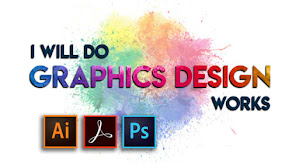The Impact of Graphic Designers:
The work of graphic designers reverberates through various aspects of modern life:
Branding and Identity: Logos are the visual embodiment of a brand, and graphic designers are instrumental in creating these iconic symbols that leave a lasting imprint on people's minds. A well-designed logo can convey a company's values, personality, and mission at a glance.
Marketing and Advertising: From print ads to digital banners, graphic designers produce visuals that captivate audiences and drive marketing efforts. Their designs compel viewers to take action, whether it's making a purchase, signing up for a newsletter, or attending an event.
Web Design and User Experience: Navigating a website or app should be intuitive and visually pleasing. Graphic designers working in web design ensure that user interfaces are not only functional but also aesthetically appealing, enhancing the overall user experience.
Social and Cultural Commentary: Graphic designers often use their craft to comment on social and cultural issues. Posters, illustrations, and digital art can serve as powerful tools for raising awareness and sparking conversations about important topics.
Entertainment Industry: Movie posters, book covers, album artwork—all of these are the creations of graphic designers. They contribute to the visual allure of the entertainment industry, enticing audiences and giving them a glimpse of what to expect.
Environmental and Informational Design: Signs, infographics, and wayfinding systems are integral parts of our environment. Graphic designers ensure that these elements are not only functional but also visually harmonious with their surroundings.
Challenges and Future Trends:
While graphic design offers a realm of opportunities, it's not without its challenges. Striking a balance between artistic expression and meeting client expectations can be delicate. Additionally, the digital age has brought about rapid changes in design trends, pushing designers to keep evolving their skills.
Looking ahead, several trends are poised to shape the future of graphic design:
Minimalism: The "less is more" approach continues to gain traction. Clean, minimalist designs with ample white space are not only visually pleasing but also load quickly in the digital realm.
Motion Graphics: As video content becomes increasingly popular, graphic designers are exploring motion graphics to create dynamic visuals that engage audiences on various platforms.
Responsive Design: With the prevalence of mobile devices, designing responsive layouts that adapt to different screen sizes is crucial for a seamless user experience.
Sustainability: Many designers are incorporating eco-friendly practices, opting for sustainable materials and promoting environmental consciousness through their work.
Augmented Reality (AR) and Virtual Reality (VR): The integration of AR and VR technologies opens new avenues for graphic designers to create immersive and interactive visual experiences.
Conclusion:
Graphic designers are the unsung heroes of visual communication, wielding their creative flair and technical prowess to craft designs that leave a lasting impact. Their work transcends industries and mediums, shaping how we perceive brands, absorb information, and experience the world around us. As technology continues to evolve, so will the role of graphic designers, adapting to new challenges and opportunities while continuing to fuel the ever-changing landscape of visual communication.
The Artistry and Impact of Graphic Designers - Marketing Mavericks
Marketing Mavericks
July 27, 2023
The Artistry and Impact of Graphic Designers: Shaping Visual Communication. In today's visually-driven world, graphic designers play a pivotal role in shaping how information is presented and communicated. Their creative prowess transcends industries, from advertising and marketing to web development and user experience design. These skilled professionals blend artistry and technology to craft captivating visuals that convey messages, evoke emotions, and leave lasting impressions. This article delves into the multifaceted world of graphic designers, exploring their significance, skills, and impact on modern communication.
The Essence of Graphic Design:
Graphic design is more than just arranging images and text; it's a dynamic process that merges aesthetics with functionality. At its core, graphic design aims to convey a message or idea visually, using a variety of elements like typography, colors, imagery, and layout. Whether it's a sleek logo, an eye-catching poster, a user-friendly app interface, or an engaging social media post, graphic designers infuse their creations with meaning and intent.
The Skill Set of a Graphic Designer:
Graphic designers possess a diverse skill set that enables them to translate concepts into compelling visuals. Here are some key skills that set them apart:
Creativity: A vivid imagination and the ability to think outside the box are crucial for graphic designers. They must continuously come up with fresh and innovative ideas that resonate with their target audience.
Typography: The choice of fonts and the way text is arranged can greatly impact the readability and visual appeal of a design. Graphic designers have an acute understanding of typography and use it strategically to enhance the overall composition.
Color Theory: Colors evoke emotions and carry cultural connotations. Graphic designers are well-versed in color theory, enabling them to select the perfect color palette to match the tone and message of a design.
Software Proficiency: Mastery of design software such as Adobe Creative Suite (Photoshop, Illustrator, InDesign) is a cornerstone of a graphic designer's toolkit. These tools allow them to manipulate images, create illustrations, and design layouts effectively.
Communication: Beyond visuals, graphic designers must also communicate effectively with clients, understanding their needs and translating them into designs that align with the client's vision.
Adaptability: The design landscape is constantly evolving, with new trends and technologies emerging. Graphic designers must stay adaptable to these changes to keep their work relevant.
Popular Posts
Most Recent
3/recent/post-list
Random Posts
3/random/post-list



0 Comments